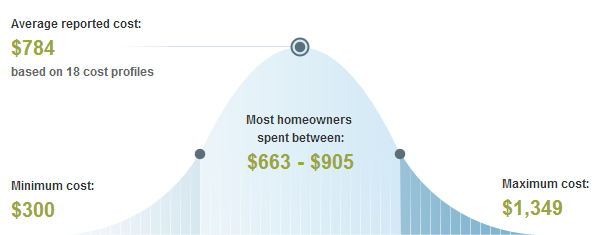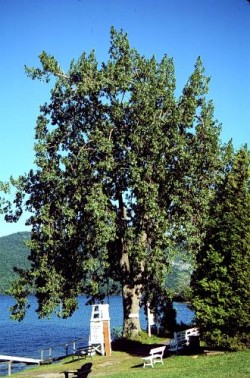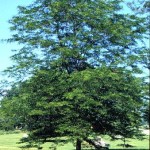Skip to a section:
- Costs – See these average costs for Lancaster tree maintenance and removal services before calling a professional.
- FAQs – Many different types of trees can grow in Lancaster, but maintaining one in the area involves knowing the rules and regulations ahead of time. Learn more.
- Services – Need more information? Call a seasoned professional in the Lancaster area today.
How Much Do Tree Services Cost in Lancaster?
The cost of general tree services in Lancaster depends on what type of services are required. Rates vary between tree removal, stump removal and basic trimming and pruning services. Here are a few details about each of these services.

Tree Removal Costs
Homeowners in Lancaster, Pennsylvania, can expect to pay around $780 to have a tree removed. However, these costs can go up for many reasons; some trees have especially difficult root systems. A tree could be too tall, or it might be located close to a power line or structure and require special equipment to take down. Larger trees can also cost more because there is much more work involved in removing the logs and branches.
Stump Removal Costs
The most common way a tree service will eliminate stumps left by felled trees is to use a stump grinder. The overall expense should account for a few things, including equipment, labor and debris removal. The cost for all of these items usually falls between $75 and $140 for medium to large stumps.
Average Cost of Tree Maintenance in Lancaster
Trees and shrubs are a low-maintenance way to add beauty to any landscape, but keep in mind that they will require periodic pruning. Routine pruning can promote good growth patterns and extend the life of a landscape. A good maintenance program will also include fertilization as well as disease and pest control. Landowners in Pennsylvania spend an average of $350 for these services per visit by an arborist.
Lancaster Tree Facts & FAQs
Before starting a tree removal project, there are a few things that landowners should know. The Pennsylvania Department of Conservation and Natural Resources has a comprehensive list of invasive tree, shrub and plant species. Before planting anything, it is a good idea to go over this list and make sure you have not selected any of these species.
City Laws
According to city code, tree owners must have a permit to cut down a shade tree “except in case of immediate necessity for the protection of life and property.” City code also states that trees overhanging streets and sidewalks must be trimmed to a minimum 9-foot clearance. As far as trees in close proximity to power lines are concerned, city code dictates that either the wire or the tree must be removed. Once a notice has been served, the landowner will have 24 hours to comply.
To remove a tree, crews often find it is easier to work in the winter months when the ground is solid. If you plan to prune 25 percent or less of the canopy of the tree or shrub, that can be done any time of the year. If you require more pruning, it is best handled in the winter months when trees and shrubs are dormant. They will be better equipped to handle the damage and will heal with spring growth.
 Besides invasive species, there are several other trees you should avoid unless you are willing to put the time and money into proper maintenance. Cottonwood (Populus deltoides) is one such tree. It quickly outgrows its space and has a shallow root system, which makes it easy to blow over in a storm and often causes damage to sidewalks and driveways. Pin oak (Quercus palustris) is another example of a tree you should reconsider. Low-growing limbs mean you will have to do a lot of tree trimming, and this species needs wet, acidic soil to stay healthy. It will require 600-square feet of yard space at the very least.
Besides invasive species, there are several other trees you should avoid unless you are willing to put the time and money into proper maintenance. Cottonwood (Populus deltoides) is one such tree. It quickly outgrows its space and has a shallow root system, which makes it easy to blow over in a storm and often causes damage to sidewalks and driveways. Pin oak (Quercus palustris) is another example of a tree you should reconsider. Low-growing limbs mean you will have to do a lot of tree trimming, and this species needs wet, acidic soil to stay healthy. It will require 600-square feet of yard space at the very least.
These trees are only a small sampling of species that have the potential for problems. As you make your selections, research each species thoroughly to make sure you can provide adequate water, nutritional and maintenance needs. Be sure to check the habits of the tree you are considering as some have a tendency to drop many sticks and require a lot of clean-up. Others might have an unpleasant odor during the blooming season or be highly prone to insects and disease.
Common Trees in Lancaster
 Although there are hundreds of trees to choose from, there are a few varieties that are commonly found in Lancaster, and with good reason. Most of these trees thrive in the Pennsylvania climate, are relatively low maintenance and make an attractive display. Some great trees to consider include the Colorado blue spruce (Picea pungens Englem), eastern white pine (Pinus strobus), flowering dogwood (Cornus florida) and the common honeylocust (Gleditsia triacanthos).
Although there are hundreds of trees to choose from, there are a few varieties that are commonly found in Lancaster, and with good reason. Most of these trees thrive in the Pennsylvania climate, are relatively low maintenance and make an attractive display. Some great trees to consider include the Colorado blue spruce (Picea pungens Englem), eastern white pine (Pinus strobus), flowering dogwood (Cornus florida) and the common honeylocust (Gleditsia triacanthos).
The state tree is the eastern hemlock (Tsuga canadensis), which is a beautiful evergreen with gracefully arching branches. This species has a diverse array of cultivars, so it is easy for homeowners to find a variety that suits their needs.
One of the best ways to add interest to your yard is to have a variety of heights. Tall trees make a majestic statement while shorter trees can provide spots of color with beautiful blooms or bold foliage. Here is a list of popular short and tall trees in Lancaster, Pennsylvania:
Short Trees:
- Korean stewartia (Stewartia koreana)
- Kousa dogwood (Cornus kousa)
- Redbud “forest pansy” (Cercis canadensis)
- Serviceberry “autumn brilliance” (Amalanchier)
- Sweetbay magnolia (Magnolia virginiana)
- Paperbark maple (Acer griseum)
- Seven-son flower (Heptacodium miconioides)
Tall Trees:
- Red maple (Acer rubrum)
- Yellow poplar (Liriodendron tulipifera)
- American sycamore (Platanus occidentalis)
- American elm (Ulmus Americana)
- River birch (Betula nigra)
Almost any fruit can be grown in Lancaster: apples, cherries, peaches, pears, plums and more. The exceptions are citrus trees such as lemons, limes and oranges. Pennsylvania residents can also grow a variety of rare fruits such as persimmons, chokecherries, pawpaws, hardy kiwis and black cherries. Landowners can also enjoy many different nut trees including walnuts, hardy pecans and butternuts.
Diseases Common to the Area
Unfortunately, there are a number of diseases that can affect Lancaster trees. The most common diseases among ornamentals include Dutch elm disease, maple decline, fire blight and root and butt rot. The Pennsylvania Department of Conservation and Natural Resources has provided a helpful resource detailing some of the diseases that often occur in Pennsylvania and the best ways to diagnose and treat them. While disease among trees is not too common, treating or removing sick trees is crucial to keep blights from spreading to the rest of your landscape or even throughout the state.
Plant Hardiness Zones in Pennsylvania
Here are the plant hardiness zones for Pennsylvania as provided by the USDA:

Image Sources:
Cottonwood
Honeylocust
Local Tree Services in Lancaster
